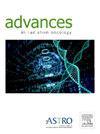Assessing Dosimetric Benefits of Cone Beam Computed Tomography-Guided Online Adaptive Radiation Treatment Frequencies for Lung Cancer
IF 2.7
Q3 ONCOLOGY
引用次数: 0
Abstract
Purpose
Online adaptive radiation therapy (oART) has shown the ability to diminish interfraction variations. However, oART is a time- and labor-intensive process, and the optimal adaptation frequency remains to be determined for lung cancer oART. The purpose of this study was to quantify and assess dosimetric benefits associated with various adaptive frequencies in patients with lung cancer receiving oART.
Methods and Materials
This study included 8 patients with lung cancer receiving oART treated on the Ethos platform in 30 or 33 fractions (n = 7 /1). For a total of 243 fractions, daily contours on cone-beam computed tomography (CT) and adaptive/nonadaptive plans on synthetic CT scan were used to simulate 4 different adaptation frequencies: none, single, weekly, and daily adaptation, resulting in 972 unique dose distributions. Dose-volume-histograms of targets and organs-at-risk (OARs) were compared between adaptation frequencies. Besides Dose-volume-histogram analysis, 3 radiation oncologists reviewed and scored 185 total plans, evenly sampling plans from the various adaptive frequencies. A comprehensive plan scorecard was fine-tuned to correlate with physician reviews and subsequently used for interplan comparison.
Results
Compared with no adaptation, daily adaptation improved the median clinical target volume V100% by 0.2% (IQR, 0.0-1.0) and the planning target volume D98% by 0.5% (IQR, −2.2 to 3.83). It also reduced the planning target volume D0.03cc by 2.1% (IQR, 0.7-3.2), the lungs-internal target volume V20 Gy by 2.5% (IQR, 1.0-4.5), the heart Dmean by 0.9 Gy (IQR, 0.4-2.6), and the esophagus Dmean by 1.6 Gy (IQR, 0.3-4.3). Single and weekly adaptation presented fewer benefits in OAR sparing and led to target undercoverage compared with daily adaptation. The PlanScoreCard effectively quantified plan quality, showing a positive monotonic correlation to physician scores (R = 0.57-0.87). It revealed that daily adaptation significantly improved total plan quality for 7 out of 8 patients, with improvements exceeding 5% of the plan score compared with no adaptation. In contrast, weekly and single adaptations led to improvements in only 2 and 1 patients, respectively.
Conclusions
Online kilovoltage cone-beam CT scan-guided daily adaptation may lead to dosimetric benefits in both target coverage and OAR sparing in patients with lung cancer. Other adaptation frequencies are effective for some patients but tend to lead to target undercoverage compared with daily adaptation.
评估锥束计算机断层扫描引导的在线自适应放疗频率对肺癌的剂量学益处
目的在线适应性放射治疗(oART)已显示出减少干涉变异的能力。然而,oART是一个时间和劳动密集型的过程,肺癌oART的最佳适应频率仍有待确定。本研究的目的是量化和评估接受oART治疗的肺癌患者与不同适应频率相关的剂量学益处。方法与材料本研究纳入8例在Ethos平台上接受oART治疗的肺癌患者,分为30组和33组(n = 7 /1)。采用锥束计算机断层扫描(CT)上的日等值线和合成CT扫描上的自适应/非自适应方案,模拟了4种不同的适应频率:无适应、单次适应、每周适应和每日适应,得到972种独特的剂量分布。在适应频率之间比较目标和危险器官(OARs)的剂量-体积-直方图。除了剂量-体积-直方图分析外,3名放射肿瘤学家对185个总方案进行了评估和评分,这些方案均匀地从各个自适应频率中抽样。一个综合计划记分卡被微调,与医生的评价相关联,随后用于计划间比较。结果与不适应相比,每日适应使临床靶体积中位数V100%提高0.2% (IQR, 0.0-1.0),计划靶体积D98%提高0.5% (IQR, - 2.2至3.83)。计划靶体积D0.03cc降低2.1% (IQR, 0.7-3.2),肺-内脏靶体积V20 Gy降低2.5% (IQR, 1.0-4.5),心脏靶体积降低0.9 Gy (IQR, 0.4-2.6),食道靶体积降低1.6 Gy (IQR, 0.3-4.3)。与每日适应相比,单次和每周适应在OAR节约方面的效益较小,并导致目标覆盖不足。PlanScoreCard有效地量化了计划质量,与医生评分呈单调正相关(R = 0.57-0.87)。结果显示,8名患者中有7名患者的日常适应显著提高了总计划质量,与没有适应的患者相比,每日适应的改善幅度超过了计划评分的5%。相比之下,每周和单次适应分别只导致2例和1例患者的改善。结论在线千电压锥束CT扫描引导下的日常适应可能在肺癌患者的靶覆盖和OAR保留方面带来剂量学上的益处。其他适应频率对部分患者有效,但与日常适应相比,往往导致目标覆盖不足。
本文章由计算机程序翻译,如有差异,请以英文原文为准。
求助全文
约1分钟内获得全文
求助全文
来源期刊

Advances in Radiation Oncology
Medicine-Radiology, Nuclear Medicine and Imaging
CiteScore
4.60
自引率
4.30%
发文量
208
审稿时长
98 days
期刊介绍:
The purpose of Advances is to provide information for clinicians who use radiation therapy by publishing: Clinical trial reports and reanalyses. Basic science original reports. Manuscripts examining health services research, comparative and cost effectiveness research, and systematic reviews. Case reports documenting unusual problems and solutions. High quality multi and single institutional series, as well as other novel retrospective hypothesis generating series. Timely critical reviews on important topics in radiation oncology, such as side effects. Articles reporting the natural history of disease and patterns of failure, particularly as they relate to treatment volume delineation. Articles on safety and quality in radiation therapy. Essays on clinical experience. Articles on practice transformation in radiation oncology, in particular: Aspects of health policy that may impact the future practice of radiation oncology. How information technology, such as data analytics and systems innovations, will change radiation oncology practice. Articles on imaging as they relate to radiation therapy treatment.
 求助内容:
求助内容: 应助结果提醒方式:
应助结果提醒方式:


